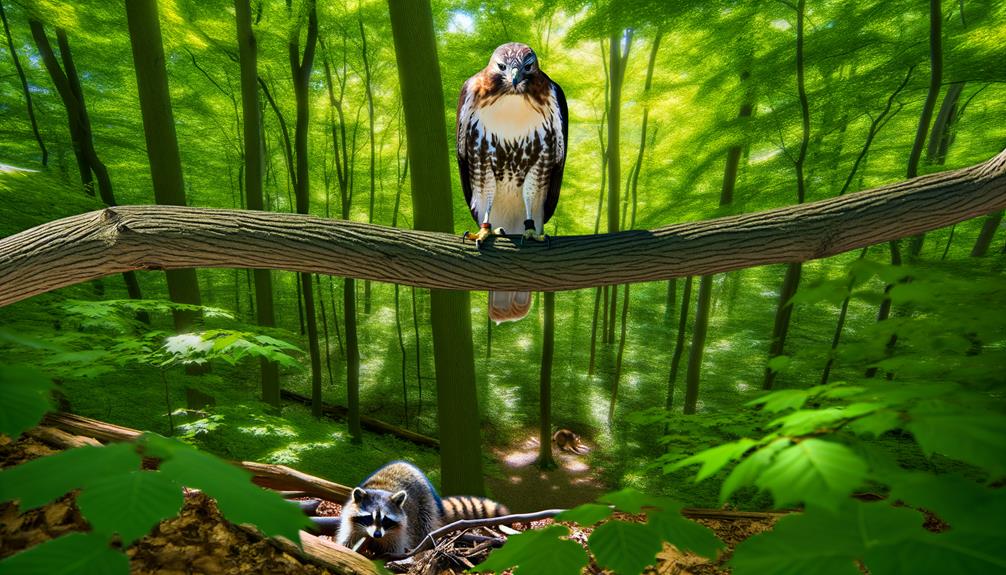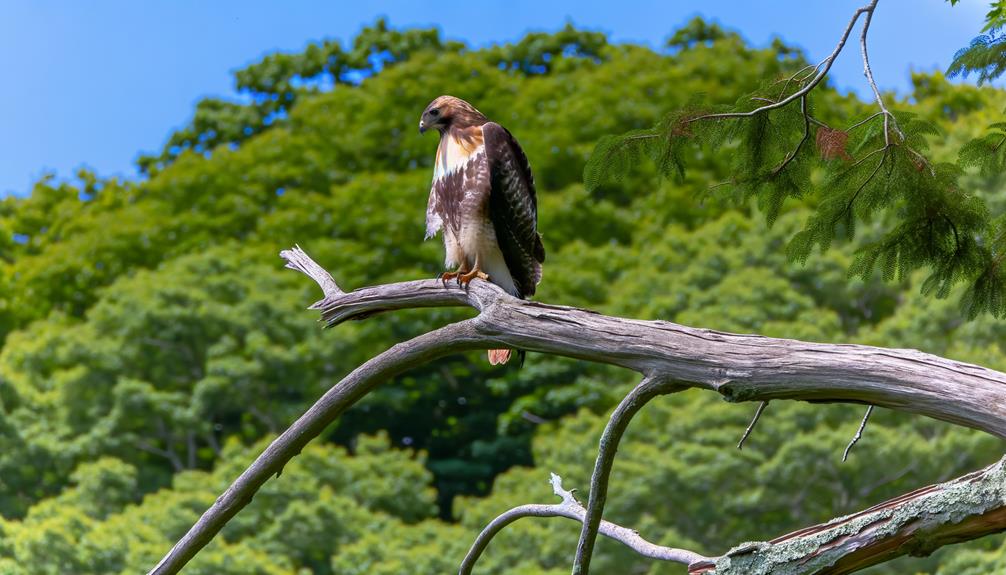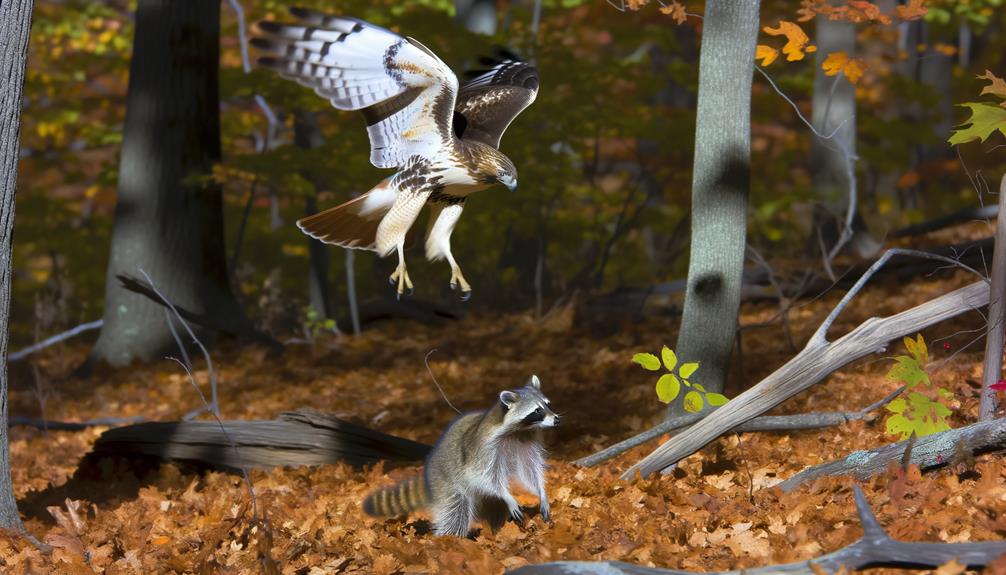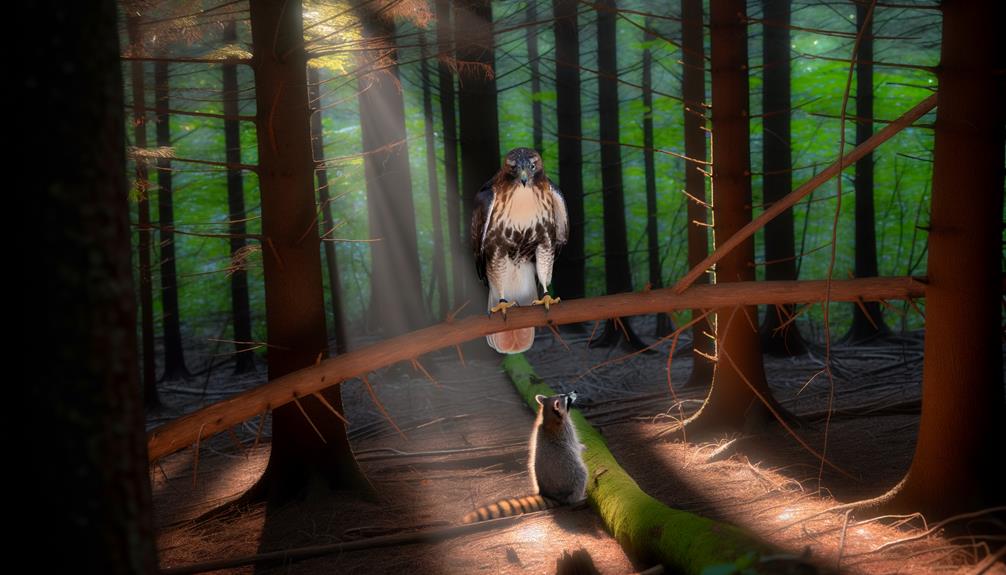Do Red-Tailed Hawks Eat Raccoons?
Red-tailed hawks exhibit a wide trophic niche, preying primarily on small to medium-sized mammals, birds, and reptiles. However, raccoons, weighing 5-20 pounds, generally surpass the hawks' preferred prey size.
Their defensive behaviors, including sharp claws and teeth, further reduce predation likelihood. Field studies indicate rodents make up nearly 85% of the hawk's diet, underscoring their preference for less risky prey.
Despite this, juvenile or injured raccoons could be targeted opportunistically, especially if traditional prey is scarce. For a detailed understanding of predatory behavior and unusual prey patterns, the following sections provide insightful information.

Key Takeaways
- Red-tailed hawks primarily consume small to medium-sized mammals, birds, reptiles, and insects, with rodents comprising 85% of their diet.
- They rarely pursue larger prey like adult raccoons due to increased risk and size differences.
- Juvenile or injured raccoons may occasionally be targeted due to their vulnerability.
- Unusual prey selection occurs during scarcity of traditional prey or opportunistic behavior.
- Red-tailed hawks use keen vision and powerful talons, but raccoons' defensive capabilities make them challenging prey.
Red-Tailed Hawk Overview

The Red-Tailed Hawk (Buteo jamaicensis) is a raptor species widely studied due to its distinctive morphology, diverse prey spectrum, and extensive habitat range across North America. Characterized by its robust body, broad wings, and, most distinctively, a rich, red tail, this hawk exhibits sexual dimorphism, with females typically larger than males.
Observational data indicate that they inhabit a variety of environments, including deserts, grasslands, and forests, with a preference for open areas with high perches. Their flight patterns, involving soaring and circling, facilitate efficient hunting and territorial surveillance.
Breeding pairs establish territories ranging from 1 to 2 square miles, and nests are often constructed in tall trees or cliffs, providing ideal vantage points for monitoring prey and potential threats.
Typical Diet of Red-Tailed Hawks
Red-tailed hawks exhibit a varied diet that primarily consists of small to medium-sized mammals, birds, and reptiles, reflecting their adaptability and opportunistic hunting behavior. This dietary flexibility allows them to thrive in diverse habitats. Key prey items include rodents, lagomorphs, and avian species, indicative of their broad trophic niche. Additionally, they consume reptiles such as snakes and lizards, contributing to their ecological role as apex predators.
| Prey Type | Examples |
|---|---|
| Mammals | Rodents, rabbits |
| Birds | Pigeons, sparrows |
| Reptiles | Snakes, lizards |
| Other | Insects, amphibians |
These observations are supported by multiple field studies that have quantified prey selection, emphasizing the red-tailed hawk's capacity for dietary adaptation in response to prey availability.
Hunting Techniques and Skills

Red-tailed hawks exhibit advanced aerial hunting strategies, leveraging their keen vision and powerful talons to capture prey with remarkable precision and timing. Studies indicate that these raptors primarily select prey based on size, vulnerability, and environmental conditions, optimizing their energy expenditure.
Data from field observations reveal that while small mammals and birds are common targets, larger prey such as raccoons are less frequently pursued due to the increased risk and effort required.
Aerial Hunting Strategies
Possessing keen eyesight and remarkable agility, Buteo jamaicensis employs sophisticated aerial hunting strategies that enable the successful capture of diverse prey, including small mammals and birds.
Utilizing dynamic soaring techniques, these raptors exploit thermals and updrafts to gain altitude efficiently. Once a target is identified, the red-tailed hawk executes a controlled dive, or stoop, achieving speeds up to 190 kilometers per hour.
During this high-velocity descent, precise adjustments of wing and tail feathers maintain aerodynamic stability. Observational data indicates that Buteo jamaicensis can spot prey from a distance of up to one mile, facilitating early detection and strategic planning.
Such advanced hunting methodologies underscore their adaptability and success as apex aerial predators.
Precision and Timing
Through meticulously timed maneuvers and acute spatial awareness, Buteo jamaicensis exemplifies precision in its hunting techniques, optimizing the success rate of its predatory engagements. Utilizing keen eyesight, the hawk can identify prey from a distance of up to 100 feet.
Once a target is selected, the hawk employs rapid, controlled dives, achieving speeds of 120 mph. These dives are precisely calculated to intercept the prey with minimal energy expenditure. Aerodynamic wing adjustments allow for fine-tuned directional changes during descent, enhancing accuracy.
Data indicates a success rate of approximately 25-30% in predatory attempts, a demonstration of the hawk's evolved proficiency. The synchronization of visual acuity and flight mechanics underscores the species' adeptness in capturing elusive or evasive targets.
Prey Selection Process
Building on their precision and timing, Buteo jamaicensis employs a multifaceted prey selection process that is informed by environmental cues, prey availability, and energetic needs.
Utilizing keen visual acuity, these raptors assess prey density and distribution, often targeting small mammals such as rodents, which comprise approximately 85% of their diet. Their hunting techniques include soaring and scanning landscapes from elevated perches to identify potential prey.
When larger prey such as raccoons are considered, factors such as the prey's defensive capabilities and the hawk's energy expenditure are meticulously evaluated. In instances where energetic returns justify the effort, a calculated stoop—an aerodynamic dive—is executed to capture the target with talons adapted for immobilization and swift dispatch.
Size and Strength Comparison
The comparison of physical size reveals that adult red-tailed hawks typically weigh between 1.5 to 3 pounds with a wingspan of approximately 4 feet.
Whereas adult raccoons can weigh 8 to 20 pounds.
Predatory strength analysis indicates that while red-tailed hawks possess powerful talons and beaks capable of subduing small mammals, the muscular build and defensive capabilities of raccoons, including sharp claws and teeth, present significant challenges.
These factors must be considered to understand the dynamics of potential predatory interactions between these species.
Physical Size Differences
Although both species are formidable in their own right, the stark differences in size and strength between red-tailed hawks and raccoons are evident upon closer examination.
Red-tailed hawks (Buteo jamaicensis) typically exhibit a wingspan ranging from 114 to 133 centimeters and weigh between 690 to 1,300 grams. In contrast, raccoons (Procyon lotor) display a body length of 40 to 70 centimeters and weigh approximately 3.5 to 9 kilograms. These metrics indicate that raccoons surpass red-tailed hawks significantly in body mass.
Anatomically, the hawk's talons and beak are adapted for piercing and tearing, while the raccoon's robust musculature and dexterous forepaws enable it to manipulate and handle diverse objects. Such physical disparities underscore the unique ecological niches occupied by each species.
Predatory Strength Contrast
Red-tailed hawks, despite their relatively smaller size, exhibit remarkable predatory strength through their powerful talons and keen eyesight, which enable them to capture and subdue a variety of prey.
With a wingspan averaging between 105-141 cm and weight around 690-1600 grams, these raptors can exert a gripping force of approximately 200 psi. Their primary weapons, the talons, are adapted for piercing and holding onto prey, ensuring minimal escape opportunity.
In contrast, raccoons, weighing between 3.5 to 9 kg, possess greater overall body strength and defensive capabilities. However, the hawk's aerial advantage and specialized hunting adaptations often allow it to target smaller or juvenile raccoons.
Consequently, the predatory strength of red-tailed hawks, while impressive, is generally optimized for prey smaller than raccoons.
Defensive Capabilities Compared
Evaluating the defensive capabilities of raccoons and red-tailed hawks reveals a complex interplay between size, strength, and adaptive strategies. Raccoons, weighing 8-20 pounds, possess robust musculature and sharp claws, facilitating effective terrestrial defense. In contrast, red-tailed hawks, weighing 2-4 pounds, leverage aerial agility and talon strength for predatory dominance.
| Attribute | Raccoon | Red-Tailed Hawk |
|---|---|---|
| Weight | 8-20 pounds | 2-4 pounds |
| Musculature | Strong, robust | Moderate, agile |
| Defense Mechanism | Claws, biting, strength | Talons, flight |
| Adaptive Strategy | Nocturnal, burrowing | Diurnal, soaring |
The hawk's flight provides a strategic advantage, while the raccoon's physical strength and nocturnal behavior offer significant terrestrial defenses. This dichotomy underscores the unique adaptations each species employs for survival.
Instances of Unusual Prey

Instances of Red-tailed Hawks preying on raccoons are exceptionally rare and typically occur under specific environmental or behavioral conditions. These raptors generally prefer smaller, more manageable prey, but occasional deviations have been documented.
Notable instances often involve:
- Juvenile or injured raccoons: Vulnerable due to size or health, making them easier targets.
- Scarcity of traditional prey: Environmental factors such as drought can lead to a shortage of usual food sources, prompting hawks to expand their diet.
- Opportunistic behavior: Hawks may exploit an unguarded moment when raccoons are isolated or distracted.
These occurrences underscore the adaptability of Red-tailed Hawks in response to fluctuating ecological variables, although such predation events remain anomalies in their dietary patterns.
Raccoons as Potential Prey
Raccoons, being omnivorous mammals with a nocturnal lifestyle, present a complex and infrequent prey option for Red-tailed Hawks, primarily due to their size, defensive capabilities, and typical activity patterns. These factors collectively reduce the likelihood of raccoons being targeted by these raptors. Red-tailed Hawks typically hunt smaller, diurnal prey, which aligns better with their hunting strategies and energy expenditure needs. Additionally, raccoons often exhibit strong defensive behaviors that can deter potential avian predators.
| Factor | Raccoons | Red-tailed Hawks |
|---|---|---|
| Diet | Omnivorous | Carnivorous |
| Activity Pattern | Nocturnal | Diurnal |
| Size | Medium (5-20 lbs) | Small to Medium (2-4 lbs) |
| Defensive Behavior | Strong | Moderate |
| Hunting Strategy | Opportunistic foragers | Active hunters |
These attributes collectively render raccoons an improbable prey choice for Red-tailed Hawks.
Expert Opinions and Observations

Observing the predatory behaviors of Red-tailed Hawks, ornithologists have noted that while these raptors have the capability to subdue larger prey, instances of them targeting raccoons are exceptionally rare and often anecdotal. Data collected through field observations and tracking studies indicate a preference for smaller mammals, birds, and reptiles. Expert opinions suggest that the considerable size and defensive abilities of raccoons make them less favored targets.
Field Studies: Analysis shows that Red-tailed Hawks mainly hunt rodents and small birds.
Behavioral Observations: Raccoons exhibit nocturnal activity patterns, reducing encounters with diurnal Red-tailed Hawks.
Predatory Tactics: Hawks prefer prey that can be subdued quickly to minimize energy expenditure and risk.
These insights underscore the scarcity of raccoons in the diet of Red-tailed Hawks.
Conclusion
The predation of raccoons by red-tailed hawks, while rare, can be compared to a chess game where the hawk's strategy and physical prowess occasionally align to secure an unconventional victory.
Despite their typical diet of smaller mammals, birds, and reptiles, red-tailed hawks possess the requisite strength and hunting acumen to target larger prey like raccoons under specific circumstances.
This phenomenon underscores the adaptability and opportunistic nature of these raptors in diverse ecological landscapes.






